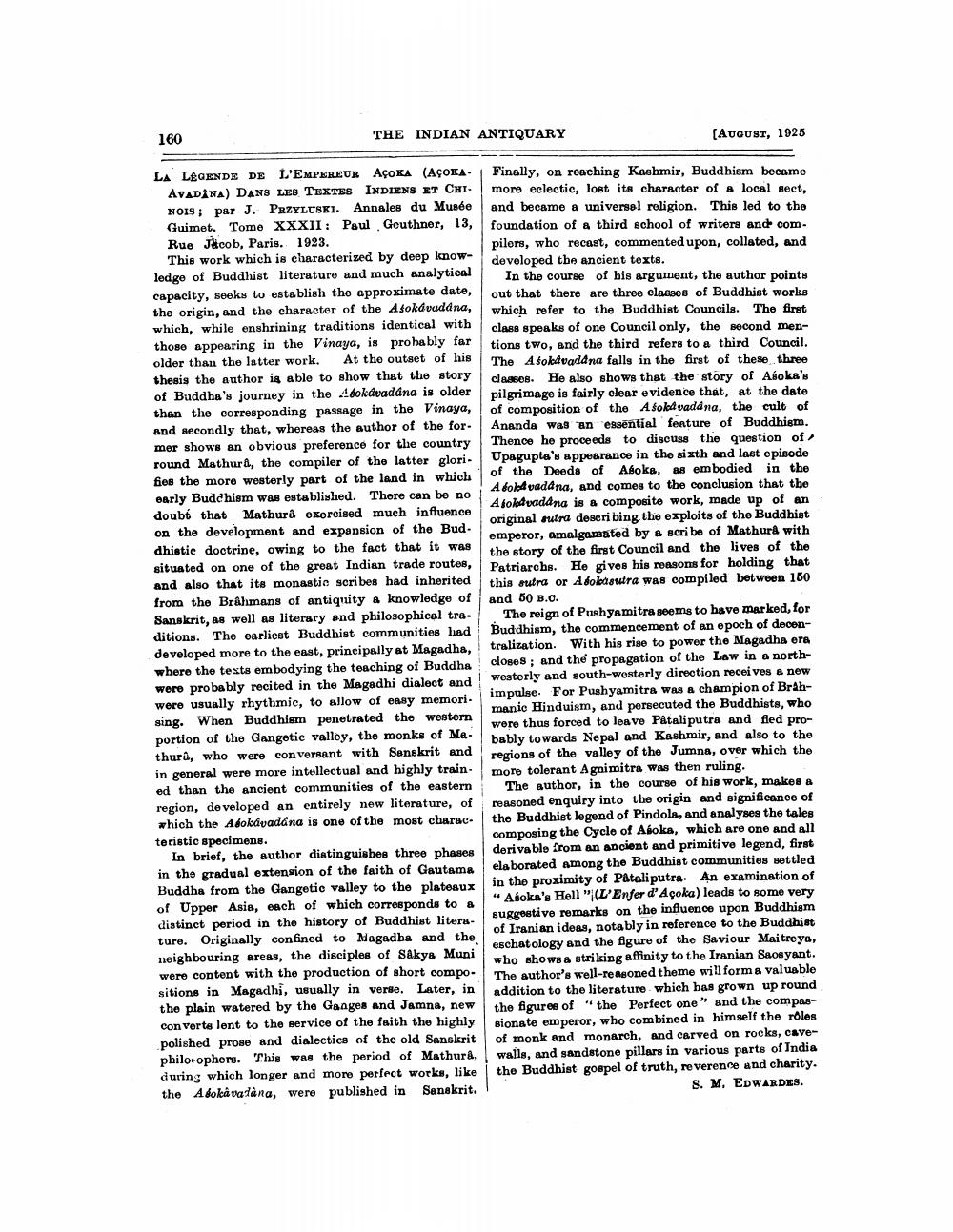________________
160
THE INDIAN ANTIQUARY
(AUGUST, 1925
LA LEGENDE DE L'EMPEREUR AÇOKA (AGOKA. Finally, on reaching Kashmir, Buddhism became
AVADANA) DANS LES TEXTES INDIENS ET CHI. more eclectic, lost its character of a local sect, NOIS; par J. PRZYLUSKI. Annales du Musée and became a universal religion. This led to the Guimet. Tome XXXII: Paul Geuthner, 13, foundation of a third school of writers and comRue Jacob, Paris. 1923.
pilors, who recost, commented upon, collated, and This work which is characterized by deep know
developed tbe ancient texts. ledge of Buddhist literature and much analytical
In the course of his argument, the author pointe capacity, seeks to establish the approximate date,
out that there are three classes of Buddhist works the origin, and the character of the Asokávuddna,
which refer to the Buddhist Councils. The first which, while enshrining traditions identical with
class speaks of one Council only, the second menthoso appearing in the Vinaya, is probably far
tions two, and the third refers to a third Council. older than the latter work. At the outset of his
The A sokavadana falls in the first of these three thesis the author is able to show that the story
classes. He also shows that the story of Asoka's of Buddha's journey in the 4 fokdvadána is older
pilgrimage is fairly clear evidence that, at the date than the corresponding passage in the Vinaya, of composition of the Atolei vadana, the cult of and secondly that, whereas the author of the for. Ananda was an essential feature of Buddhism. mer shows an obvious preference for the country Thence he proceeds to discuss the question of round Mathuri, the compiler of the latter glori
Upagupta's appearance in the sixth and last episode fies the more westerly part of the land in which
of the Deeds of Aboka, as embodied in the
Adoled vadana, and comes to the conclusion that the early Buddhism was established. There can be no doubt that Mathurà exercised much influence
A foltvadana is a composite work, made up of an on the development and expansion of the Bud.
original outra describing the exploits of the Buddhist
emperor, amalgamated by a scribe of Mathurd with dhistic doctrine, owing to the fact that it was
the story of the first Council and the lives of the situated on one of the great Indian trade routes,
Patriarchs. He gives his reasons for holding that and also that its monastic scribes had inherited
this sutra or Adoldsutra was compiled between 160 from the Brahmans of antiquity a knowledge of i and 60 B.O. Sanskrit, as well as literary and philosophical tre. The reign of Pushyamitra seems to have marked, for ditions. The earliest Buddhist communities had Buddhism, the commencement of an epoch of decendeveloped more to the east, principally at Magadha,
tralization. With his rise to power the Magadha era where the texts embodying the teaching of Buddha
closes; and the propagation of the Law in a northwere probably recited in the Magadhi dialect and
westerly and south-wosterly direction receives a new were usually rhythmic, to allow of easy memori.
impulse. For Pushyamitra was a champion of Brah
manic Hinduism, and persecuted the Buddhists, who sing. When Buddhism penetrated the western
were thus forced to leave Pataliputra and fled proportion of the Gangetic valley, the monks of Ma.
bably towards Nepal and Kashmir, and also to the thura, who were con versant with Sanskrit and
regions of the valley of the Jumna, over which the in general were more intellectual and highly train. more tolerant Agnimitra was then ruling. ed than the ancient communities of the eastern The author, in the course of his work, makes a region, developed an entirely new literature, of reasoned enquiry into the origin and significance of which the Adokávadana is one of the most charac. the Buddhist legend of Pindola, and analyses the tales teristic specimens.
composing the Cycle of Aboka, which are one and all In brief, the author distinguishes three phases
derivable from an ancient and primitive legend, first in the gradual extension of the faith of Gautama elaborated among the Buddhist communities settled Buddha from the Gangetic valley to the plateaux
in the proximity of Pataliputra. An examination of of Upper Asia, each of which corresponds to a
" Asoka's Hell "(L'Enfer d'Acoka) leads to some very distinct period in the history of Buddhist litera
suggestive remarks on the influence upon Buddhism ture. Originally confined to Magadba and the
of Iranian ideag, notably in reference to the Buddhist
eschatology and the figure of the Saviour Maitreya, neighbouring areas, the disciples of SAkya Muni
who shows & striking affinity to the Iranian Saosyant. were content with the production of short compo.
The author's well-reasoned theme will form a valuable sitions in Magadhi, usually in verse. Later, in
addition to the literature which has grown up round the plain watered by the Ganges and Jamna, new
the figures of the Perfect one" and the compascon verts lent to the service of the faith the highly sionate emperor, who combined in himself the roles polished prose and dialectics of the old Sanskrit of monk and monarch, and carved on rocks, cavephilo-ophers. This was the period of Mathura, walls, and sandstone pillars in various parts of India during which longer and more perfect works, like the Buddhist gospel of truth, reverence and charity. the A doká valana, were published in Sanskrit.
S. M. EDWARDES.




